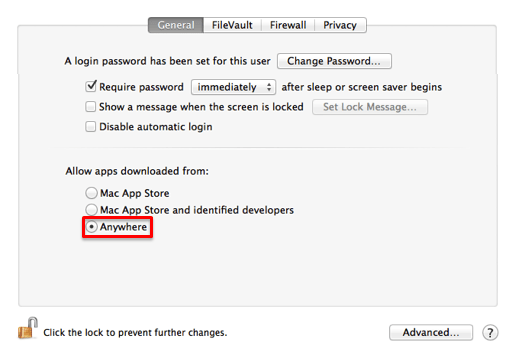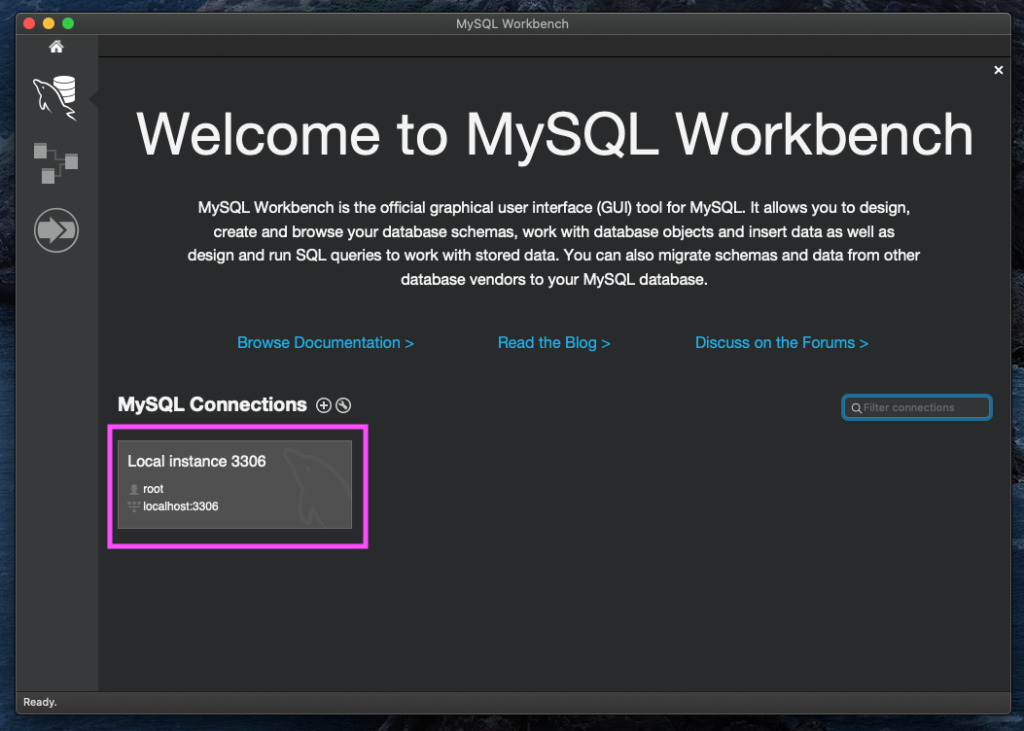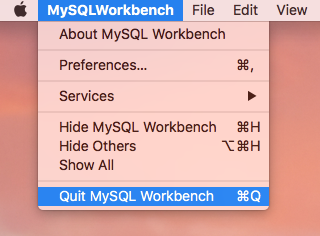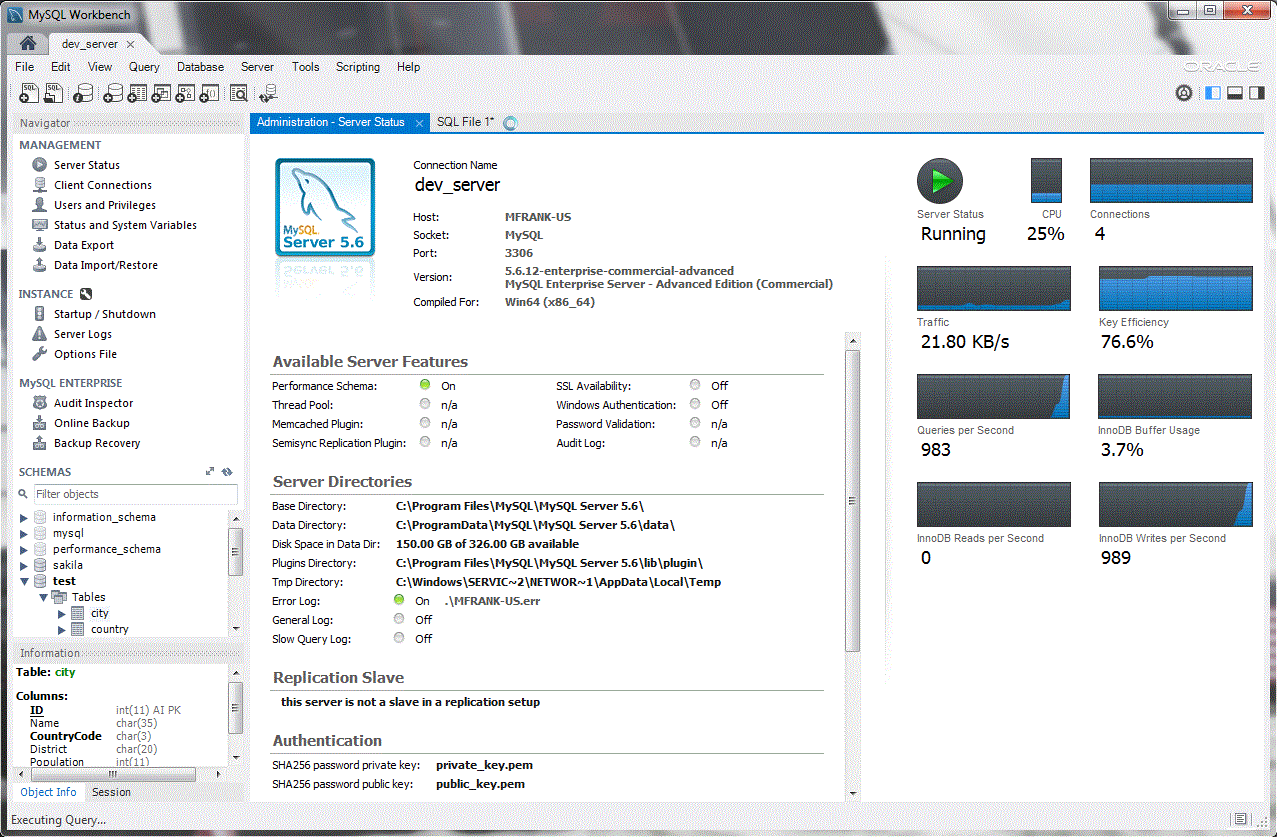Mysql Workbench For Mac 10.11.6 Summary Mysql Workbench For Mac Os X. MySQL is an open source relational database that is cross platform. MySQL supports multiple storage engines which greatly improve the server performance tuning and flexibility. Free download MySQL Workbench OSS MySQL Workbench OSS for Mac OS X. MySQL Workbench OSS - MySQL Workbench enables a DBA, developer, or data architect to visually design, generate, and manage all types of databases including Web, OLTP, and data. Download MySQL for OS X. Download latest stable version of MySQL server for your OS X version and architecture. Unpack download. Install MySQL from downloaded file. Install and setup auto start package for MySQL on OS X. Connect to installed MySQL server.
Install and configure a MySQL database
To install the database, you don't need to install Microsoft .NET Framework 3.5. If you run into any issues installing and configuring the database, look at the README.txt file included in the DMG Archive for some useful tips.
- Download MySQL Community Server 5.5 DMG Archive.
- Double-click the DMG Archive, and then double-click the .pkg file that starts with mysql-5.5. Follow the instructions to install the MySQL server.
- Double-click the MySQLStartupItem.pkg file, and follow the instructions in the setup wizard. The wizard installs the MySQL server as an auto-startup item.
- Double-click the MySQL.prefPane file. The file installs the MySQL control panel into the System Preferences application so that you can control the MySQL server.
- Open the System Preferences application, and perform the following actions:
- In the Other section, click the MySQL icon.
- Click Start MySQL server to start the server.
- At the bottom of the control panel, you can also configure the MySQL server to run automatically on startup.
- To make it easier to access the mysql and mysqladmin programs, you can modify the PATH environment variable by performing the following actions:
- From a terminal window in your home directory, type the following command:
- Add the following statement to your existing PATH environment variable, or create a new entry if a PATH variable isn't already defined:
- Close the current terminal window, and open a new one for the changes to the PATH variable to take effect.
- From the terminal window, type the following command to set the root password:
- Change some of the default configuration values for MySQL so that they're more suitable for the Push Service SDK by performing the following actions:
- From a terminal window, type the following commands to copy one of the sample MySQL configuration files so that you can modify it:
- Open the configuration file by typing the following command:
- Add the following statements to the [mysqld] section of my.cnf file:
The first statement configures the database so that it behaves like a traditional SQL database management system. The remaining statements configure the database so that it uses a UTF-8 character encoding.
If you want to use a case-insensitive collation instead of a case-sensitive one, change collation_server to utf8_unicode_ci.
- Copy the modified my.cnf to /etc by typing the following command:
- Open the System Preferences application, and in the Other section, click the MySQL icon.
- Stop the MySQL server, and then start it again for the changes to take effect.
Create a server instance
- Download MySQL Workbench 5.2.
- On the Home screen for the MySQL Workbench, in the Server Administration section, click New Server Instance.
- Specify your root password by clicking Store In Keychain. Leave the remaining configuration values as they are.
- On the Create the Instance Profile screen, type the server instance name (for example, pushsdk).

Create the database schema
- On the Home screen for the MySQL Workbench, in the SQL Development section, double-click the database connection that you created when you created the server instance for the database.
- Click the dummy database in the Schema section, and then right-click and choose Create Schema.
- In the Name field, specify a name for the database schema (for example, pushsdk).
- In the Default Collation drop-down list, click utf8_bin for a case-sensitive collation type, or utf8_unicode_ci for a case-insensitive collation type.
- Click Apply twice.
- Click Close.
Create a user account for the database schema
The user account that you set up in this task is the user account that you use to access the database tables through a Push Initiator.
- On the Home screen for the MySQL Workbench, in the Server Administration section, double-click the server instance that you created.
- From the Management panel on the left, click Users and Privileges.
- Click Add Account at the bottom.
- Click the Login tab, and specify a login name and password for the user.
- In the Limit Connectivity to Hosts Matching field, type one or more names and host machines that the user can connect from (for example, localhost).
- Click Apply.
- On the Schema Privileges tab, in the Users column, click the user account you created.
- Click Add Entry.
- In the Host section, select the Selected host option.
- In the Selected Host drop-down list, click the host machine that you want to define the privileges for (for example, localhost).
- In the Schema section, select the Selected schema option.
- In the Selected schema list, click the database schema that you created and that you want to define the privileges for.
- Click OK.
- Select the newly created entry in the list, and click Select 'ALL' to assign the user all privileges for this database schema.
- Click Save Changes.
Create a new connection to the database schema
- On the Home screen for the MySQL Workbench, in the SQL Development section, click New Connection.
- In the Connection Name field, type a name for the connection.
- In the Hostname field, type the name of the host machine that the server instance is installed on (for example, localhost).
- In the Port field, type 3306.
- In the Username field, type the name of the user that you created for the database schema.
- In the Password field, click Store in Keychain .
- Type the password of the user that you created for the database schema.
- In the Default Schema field, type the name of the database schema that you created.
- Click OK.
Use the latest version available for download, which will be at the bottom of the downloads page. The file will look similar to psqlodbc.tar.gz. Extract this tarball to a temporary location, open a terminal, and cd into that directory. Download MySQL Community Edition ». MySQL Workbench for visual modeling, SQL development and administration; Available on over 20 platforms and operating systems including Linux, Unix, Mac and Windows. Contact MySQL Sales USA/Canada: +1-866-221-0634. MySQL Workbench is a unified visual tool for database architects, developers, and DBAs. MySQL Workbench provides data modeling, SQL development, and comprehensive administration tools for server configuration, user administration, backup, and much more. MySQL Workbench is available on Windows, Linux and Mac OS X.
MySQL Workbench is a unified visual tool for database architects, developers, and DBAs. MySQL Workbench provides data modeling, SQL development, and comprehensive administration tools for server configuration, user administration, backup, and much more. MySQL Workbench is available on Windows, Linux and Mac OS X.

Sql Workbench Mac
Performance Dashboard
查看屏幕截图:
Windows, Linux, OS X
Design
MySQL Workbench enables a DBA, developer, or data architect to visually design, model, generate, and manage databases. It includes everything a data modeler needs for creating complex ER models, forward and reverse engineering, and also delivers key features for performing difficult change management and documentation tasks that normally require much time and effort.
Learn More »

Mac Os X Download 10.6
Develop
MySQL Workbench delivers visual tools for creating, executing, and optimizing SQL queries. The SQL Editor provides color syntax highlighting, auto-complete, reuse of SQL snippets, and execution history of SQL. The Database Connections Panel enables developers to easily manage standard database connections, including MySQL Fabric. The Object Browser provides instant access to database schema and objects.
Learn more »
Administer

MySQL Workbench provides a visual console to easily administer MySQL environments and gain better visibility into databases. Developers and DBAs can use the visual tools for configuring servers, administering users, performing backup and recovery, inspecting audit data, and viewing database health.
Learn more »
Visual Performance Dashboard
MySQL Workbench provides a suite of tools to improve the performance of MySQL applications. DBAs can quickly view key performance indicators using the Performance Dashboard. Performance Reports provide easy identification and access to IO hotspots, high cost SQL statements, and more. Plus, with 1 click, developers can see where to optimize their query with the improved and easy to use Visual Explain Plan.
Learn More »
Database Migration
Mysql Workbench For Mac Os X Download Free
Mysql Workbench Download For Mac
MySQL Workbench now provides a complete, easy to use solution for migrating Microsoft SQL Server, Microsoft Access, Sybase ASE, PostreSQL, and other RDBMS tables, objects and data to MySQL. Developers and DBAs can quickly and easily convert existing applications to run on MySQL both on Windows and other platforms. Migration also supports migrating from earlier versions of MySQL to the latest releases.
Learn more »
Additional Resources
Mac Os X Download Iso
Another great thing about MySQL Workbench is that the program gives you a visual representation of the tables, views, stored procedures, and foreign keys for the database. Plus, the program is able to synchronize the development model with the real database.
MySQL Workbench also lets you generate the necessary script to create the database designed in the schema. This is added to the compatibility offered with the database models from DBDesigner 4 and lets you complete migrations with previous versions of MySQL. Plus, the program offers support for the migration of Microsoft SQL Server, Microsoft Access, Sybase ASE, and PostreSQL.